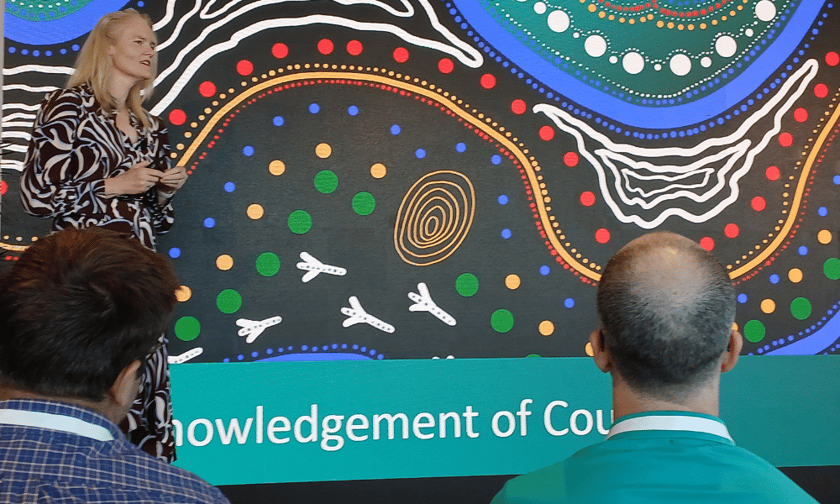

This week, NSW has experienced heatwave conditions with Eastern parts of the state reaching temperatures close to 40 degrees Celsius. According to the Bureau of Meteorology (BOM), Australia could be about to start one of the hottest summers on record.
The increased risk of destructive and deadly bushfires in the months ahead brings serious implications for government, insurers, brokers and homeowners. Many industry stakeholders agree that the heightened risk underlines the need for accelerated and widespread adoption of building designs and modifications to existing homes that improve natural catastrophe resilience.
At Duck Talk 2024 last Thursday, an annual Sydney insurance event, Suncorp’s CEO of consumer insurance, Lisa Harrison (pictured above), explained how her firm is supporting customers – and educating the community and stakeholders – on how to improve the resilience of homes to nat cats.
“What this industry does, matters,” said Harrison to the delegates. “It matters to customers, it matters to community and it matters to the country.”
Harrison’s Churchillian tone captured the urgency of the situation. She said Suncorp, after several years of core technology upgrades, is now in the delivery phase of offering products to customers with preventative solutions incorporated into them.
Some of the preventative solutions in home insurance offerings came directly from two recent initiatives: One House and Resilience Road. Harrison said these initiatives are examples of “where the industry is creating value for customers.”
In 2021, Suncorp partnered with the Commonwealth Scientific and Industrial Research Organisation (CSIRO), James Cook University (JCU) and Room11 Architects to design and test a home resilient to nat cats.
Another aim of the design was affordability. Suncorp’s fact sheets say it compares to the cost “of any standard architecturally designed home built today.”
Harrison played a video where Justin Leonard, head of the CSIRO’s bushfire adaptation team, explained the fireproof testing.
These tests likely helped dislodge some widely held but erroneous beliefs about how many houses burn down during a bushfire event.
“People returning to the site where they've lost their house are often confronted with, what could I have done?” said Leonard in the video. “They very quickly move to the idea that the fire came through with such intensity that it knocked the house down and burnt it to a crisp.”
However, he said, this isn’t what usually occurs.
“But in fact, what really happens is the fire comes and finds a couple of minor ways to get inside the house and it's all the furnishings within the house that burned down over the many hours after the fire,” said Leonard. “So it really comes down to the house's ability to prevent fire and embers reaching the interior of the house.”
The One House project was taken to the next stage in 2022 with Resilience Road, another attention-grabbing initiative.
“Resilience Road is about taking what we learned from One House and applying it to real homes and real families on a real street,” said a Suncorp executive in Harrison’s video.
The project involved giving five houses on a street in Rockhampton some relatively simple and affordable resilience upgrades. These improvements ranged from installing cyclone resistant fixings, to attaching mesh screens and gutter guards.
“We are getting traction,” said Harrison. “But there's more to do.”
She said one industry challenge is how to alert customers, for example, when they live in a flood zone and then come up with products and services to help them.
One way to raise awareness, she suggested, would be to broaden the types of government subsidies available.
“You can get a subsidy to put a solar panel on your home, which is important, but you can't get a subsidy to make your home more resilient to cyclones, floods or bush fires,” said Harrison.
Other insurers have also embarked on resilience initiatives.
In 2021, NRMA Insurance partnered with the Resilient Building Council (RBC) to produce nat cat resilient house designs and building principles. According to the FORTIS House project website: “FORTIS House sets a new benchmark for better building to protect people, homes, communities and the environment.”
In 2022, the Bushfire Building Council of Australia (BBCA) publicly released these architectural designs for free download.
Other stakeholders have come up with their own resilient house designs.
Architect, designer and activist Joost Bakker has designed and built resilient and sustainable houses since the early 2000s. According to news reports, his “bushfire proof” houses have withstood CSIRO fire tests similar to the ones deployed during Suncorp’s One House trials.
He made the plans and specifications for his bushfire-resilient house built in Kinglake, Victoria, freely available via the BBCA.
Are you an insurance industry stakeholder? What more can the industry do to speed the uptake of nat cat resilient housing in Australia?
